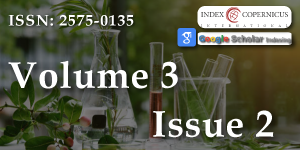Cloning and Characterization of a Pseudo-Response Regulator 7 (PRR7) Gene from Medicago Sativa Involved In Regulating the Circadian Clock
Main Article Content
Abstract
The circadian clock is an endogenous molecular oscillator with a period of about 24 hours, which regulates the physiology and developmental processes of almost all higher plants. Pseudo-response regulators (PRRs) are an important part of the central clock oscillator, together with other clock genes, constituting interlinked transcriptional feedback loops, which partly influence plant growth and development. In this study, a circadian clock-related gene MsPRR7 was cloned from Medicago sativa (alfalfa) by homologous cloning. The full length MsPRR7 gene was 2648 bp in length, with an open reading frame of 2385 bp encoding a protein of 795amino acids. Phylogenetic analysis showed that the MsPRR7 was closely related to PRR7 from the PRR family of Arabidopsis thaliana. Subcellular localization analysis found that MsPRR7 was located in the nucleus. Quantitative reverse-transcription polymerase chain reactions (qRT-PCR) demonstrated that expression of MsPRR7 gene transcripts in leaves was affected by circadian rhythms, and that its expression level increased with an extension of illumination time, reaching a peak around 8–10 hours. These results will provide the experimental basis for further study of the regulation of PRR family genes in alfalfa.
Article Details
Copyright (c) 2019 Shen Y, et al.

This work is licensed under a Creative Commons Attribution 4.0 International License.
Srikanth A, Schmid M: Regulation of flowering time: all roads lead to Rome, Cell Mol Life Sci. 2011; 68: 2013-2037. PubMed: https://www.ncbi.nlm.nih.gov/pubmed/21611891
Pittendrigh CS: Circadian rhythms and the circadian organization of living systems, Cold Spring Harb SympQuant Biol. 1960; 25: 159-184. PubMed: https://www.ncbi.nlm.nih.gov/pubmed/13736116
Pittendrigh CS: Circadian surfaces and the diversity of possible roles of circadian organization in photoperiodic induction, Proc Natl Acad Sci USA. 1972; 69: 2734-2737. PubMed: https://www.ncbi.nlm.nih.gov/pmc/articles/PMC427028/
Wang ZY, Tobin EM: Constitutive expression of the CIRCADIAN CLOCK ASSOCIATED 1 (CCA1) gene disrupts circadian rhythms and suppresses its own expression, Cell. 1998; 93: 1207-1217. PubMed: https://www.ncbi.nlm.nih.gov/pubmed/9657153
Alabadí D, Yanovsky MJ, Más P, Harmer SL, Kay SA. Critical role for CCA1 and LHY in maintaining circadian rhythmicity in Arabidopsis, Curr Biol. 2002; 12: 757-761. PubMed: https://www.ncbi.nlm.nih.gov/pubmed/12007421
Mizoguchi T, Wheatley K, Hanzawa Y, Wright L, Mizoguchi M, et al. LHY and CCA1 are partially redundant genes required to maintain circadian rhythms in Arabidopsis. Dev Cell. 2002; 2: 629-641. PubMed: https://www.ncbi.nlm.nih.gov/pubmed/12015970
Mizuno T, Nakamichi N. Pseudo-Response Regulators (PRRs) or True Oscillator Components (TOCs). Plant Cell Physiol. 2005; 46: 677-685. PubMed: https://www.ncbi.nlm.nih.gov/pubmed/15767264
Matsushika A, Makino S, Kojima M, Mizuno T. Circadian waves of expression of the APRR1/TOC1 family of pseudo-response regulators in Arabidopsis thaliana: insight into the plant circadian clock. Plant Cell physiol. 2000; 41: 1002-1012. PubMed: https://www.ncbi.nlm.nih.gov/pubmed/11100772
Murakami M, Ashikari M, Miura K. The evolutionarily conserved OsPRR quintet: rice pseudo-response regulators implicated in circadian rhythm. Plant Cell physiol. 2003; 44: 1229-1236.
Michael TP, Mockler TC, Breton G, McEntee C, Byer A, et al. Network discovery pipeline elucidates conserved time-of-day-specific cis-regulatory modules. Plos Genet. 2008; 4: 14. PubMed: https://www.ncbi.nlm.nih.gov/pubmed/18248097
Hazen SP, Naef F, Quisel T. Exploring the transcriptional landscape of plant circadian rhythms using genome tiling arrays, Genome Biol. 2009; 10: 17.
Fukushima A, Kusano M, Nakamichi N, Kobayashi M, Hayashi N, et al. Impact of clock-associated Arabidopsis pseudo-response regulators in metabolic coordination. Proc Natl Acad Sci USA. 2009; 106: 7251-7256. PubMed: https://www.ncbi.nlm.nih.gov/pubmed/19359492
Farré EM, Harmer SL, Harmon FG, Yanovsky MJ, Kay SA. Overlapping and distinct roles of PRR7 and PRR9 in the Arabidopsis circadian clock. Curr Biol. 2005; 15: 47-54. PubMed: https://www.ncbi.nlm.nih.gov/pubmed/15649364
Yamaguchi A, Kobayashi Y, Goto K, Abe M, Araki T. TWIN SISTER OF FT (TSF) acts as a floral pathway integrator redundantly with FT. Plant Cell Physiol. 2005; 46: 1175-1189.PubMed: https://www.ncbi.nlm.nih.gov/pubmed/15951566
Kolmos E, Chow BY, Pruneda-Paz JL, Kay SA. HsfB2b-mediated repression of PRR7 directs abiotic stress responses of the circadian clock. Proc Natl Acad Sci USA. 2014; 111: 16172-16177. PubMed: https://www.ncbi.nlm.nih.gov/pubmed/25352668
Gao H, Jin M, Zheng XM, Chen J, Yuan D, et al. Days to heading 7, a major quantitative locus determining photoperiod sensitivity and regional adaptation in rice, Proc Natl Acad Sci USA. Correction. 2014; 111: 16337–16342. PubMed: https://www.ncbi.nlm.nih.gov/pubmed/25378698
Yang S, Murphy RL, Morishige DT, Klein PE, Rooney WL, et al. Sorghum phytochrome B inhibits flowering in long days by activating expression of SbPRR37 and SbGHD7, repressors of SbEHD1, SbCN8 and SbCN12. Plos One. 2014; 9: 105352. PubMed: https://www.ncbi.nlm.nih.gov/pmc/articles/PMC4133345/
Turner A, Beales J, Faure S, Dunford RP, Laurie DA. The pseudo-response regulator Ppd-H1 provides adaptation to photoperiod in barley. Science. 2005; 310: 1031-1034. PubMed: https://www.ncbi.nlm.nih.gov/pubmed/16284181
Zhang W, Zhao G, Gao L, Kong X, Guo Z, et al. Functional studies of heading date-related geneTaPRR73, a paralog ofPpd1in common wheat. Front Plant Sci. 2016; 7: 772. PubMed: https://www.ncbi.nlm.nih.gov/pubmed/27313595
Digel B, Tavakol E, Verderio G, Tondelli A, Xu X, et al.: Photoperiod-H1 (Ppd-H1) controls leaf size. Plant Physiol. 2016; 172: 405-415. PubMed: https://www.ncbi.nlm.nih.gov/pubmed/27457126
Jung C, Müller AE. Flowering time control and applications in plant breeding. Trends Plant Sci. 2009; 14: 563-573. PubMed: https://www.ncbi.nlm.nih.gov/pubmed/19716745
Sparkes IA, Runions J, Kearns A, Hawes C. Rapid, transient expression of fluorescent fusion proteins in tobacco plants and generation of stably transformed plants. Nature Protocols. 2006; 1: 2019-2025. PubMed: https://www.ncbi.nlm.nih.gov/pubmed/17487191
Sato E, Nakamichi N, Yamashino T, Mizuno T. Aberrant expression of the Arabidopsis circadian-regulated APRR5 gene belonging to the APRR1/TOC1 quintet results in early flowering and hypersensitiveness to light in early photomorphogenesis. Plant Cell Physiol. 2002; 43: 1374-1385. PubMed: https://www.ncbi.nlm.nih.gov/pubmed/12461138
Makino S, Kiba T, Imamura A, Hanaki N, Nakamura A, et al. Genes encoding pseudo-response regulators: insight into His-to-Asp phosphorelay and circadian rhythm in Arabidopsis thaliana. Plant Cell Physiol. 2000; 41: 791-803. PubMed: https://www.ncbi.nlm.nih.gov/pubmed/10945350
Matsushika A, Imamura A, Yamashino T, Mizuno T. Aberrant expression of the light-inducible and circadian-regulated APRR9 Gene belonging to the circadian-associated APRR1/TOC1 quintet results in the phenotype of early flowering in Arabidopsis thaliana, Plant Cell Physiol. 2002; 43: 833-843. PubMed: https://www.ncbi.nlm.nih.gov/pubmed/12198185

